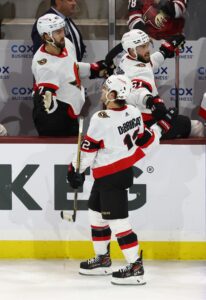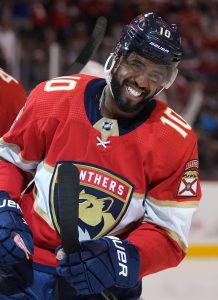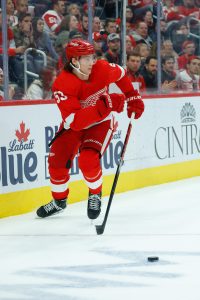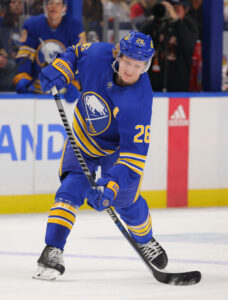Navigating the salary cap is one of the more important tasks for any GM. Teams that can avoid total cap chaos by walking the tightrope of inking players to deals that match their value (or compensate for future value without breaking the bank) remain successful. Those that don’t see struggles and front office changes.
Over the past several months, PHR has looked at every NHL team and given a thorough look at their cap situation for the 2022-23 season and beyond. This is the final piece of the series. This will focus more on players who are regulars on the roster versus those who may find themselves shuttling between the AHL and NHL. All cap figures are courtesy of CapFriendly.
Toronto Maple Leafs
Current Cap Hit: $88,851,650 (over the $82.5MM Upper Limit)
Entry-Level Contracts
F Pontus Holmberg (one year, $827.5K)
F Nicholas Robertson (two years, $796.7K)
Potential Bonuses
None
Robertson has been viewed as one of Toronto’s top prospects for a few years now. However, injuries have limited him significantly in the pros and he’s out for the rest of this season after undergoing shoulder surgery. The Maple Leafs frequently use bridge contracts and he’s a very strong candidate to get one. If he returns to health and produces, it could be around the $1.5MM mark but it’s likely to come in below that. Holmberg fit in nicely in Toronto’s bottom six and is playing his way into consideration for a full-time spot beyond this season although he’s back in the minors for the time being. Even so, with their cap situation and Holmberg’s limited NHL experience, a short-term bridge deal around the $1MM range is where his next deal should fall.
Signed Through 2022-23, Non-Entry-Level
F Noel Acciari ($1.25MM, UFA)
F Joey Anderson ($750K, RFA)
F Zach Aston-Reese ($840.6K, UFA)
D Jordie Benn ($750K, UFA)
F Michael Bunting ($950K, UFA)
F Pierre Engvall ($2.25MM, UFA)
D Justin Holl ($2MM, UFA)
F David Kampf ($1.5MM, UFA)
F Alex Kerfoot ($3.5MM, UFA)
D Victor Mete ($750K, RFA)
F Ryan O’Reilly ($1.875MM, UFA)*
G Ilya Samsonov ($1.8MM, RFA)
F Wayne Simmonds ($900K, UFA)
*-St. Louis is retaining 50% of O’Reilly’s cap hit ($3.75MM) and Minnesota is retaining an additional 25% ($1.875MM).
Kerfoot’s hold of a roster spot in Toronto has seemingly been in question for about three of his four years with the team but it’s not because he has a bad contract by any stretch. He’s on pace to push for 40 points again which, coupled with his ability to play center and the wing, should have him earning another million or so on his next deal, one that’s likely to be for more years than this four-year agreement he’s finishing now. Engvall is a capable depth forward but hasn’t shown the ability to produce consistently. Since he doesn’t kill penalties too frequently either, his market might not be the strongest. He could get something close to this amount but not considerably higher. Kampf isn’t much of a scorer himself but with him being good on faceoffs and killing penalties, there should be a market for him that should land him a multi-year deal closer to the $2MM (or even $2.5MM if enough teams show interest.).
Then there are the newcomers. O’Reilly has had a tough year this season but has a long and proven track record as a key two-way player. At 32, he still should be able to land a sizable agreement on a multi-year deal but it’s likely to be for at least a couple million less than his base $7.5MM AAV unless he has a big finish to his season with Toronto; he’s off to a good start on that front. As for Acciari, he had a nice bounce-back showing in the bottom six with St. Louis before the swap and, as a player who can hold his own on the third line or anchor the fourth, can kill penalties, plays with an edge, and win faceoffs, he’ll have a stronger market than he did last summer which should lead to a multi-year agreement and an AAV closer to the $2MM mark at least.
Bunting is going to be a particularly intriguing case to follow. He has been one of the top bargains in the NHL these last two years, providing top-six production for depth forward money. Even with what’s still a limited track record, there are enough comparable deals that could realistically push his asking price past the $5MM mark on a long-term agreement. Is that one Toronto will be able to fit into their salary structure? That’s one of the questions they’ll certainly be pondering. Aston-Reese didn’t have a strong market last summer and likely hasn’t done enough to change that so he should stay in this price range. Simmonds, if he plays another year, will be at the league minimum while Anderson should wind up there as well.
Holl might not be a top-end defender but he has held his own while logging around 21 minutes a night this season. He’s also a right-shot player, the handedness that’s always in high demand. While he was a depth defender early on in his time with the Leafs, that’s not the case now and he could add at least $1MM on his next contract which could very well price his way out of Toronto. Benn and Mete both signed minimum deals back in July and their markets haven’t changed significantly since then. Mete is arbitration-eligible once more but because he has 247 career games under his belt, he’s likely to be non-tendered to avoid that risk.
Samsonov chose to sign with Toronto in the hopes of rebuilding his value. That decision has worked out rather well so far as he is staking claim to the starting role. We’ve seen the price tag for young goalies with limited experience go up considerably lately (Samsonov has less than 130 NHL appearances even including the playoffs) and it’s plausible that his next deal could push past the $5MM mark.
Signed Through 2023-24
D T.J. Brodie ($5MM, UFA)
D Mark Giordano ($800K, UFA)
D Timothy Liljegren ($1.4MM, RFA)
F Auston Matthews ($11.64MM, UFA)
G Matt Murray ($4.688MM, UFA)*
D Jake Muzzin ($5.625MM, UFA)
F William Nylander ($6.962MM, UFA)
D Rasmus Sandin ($1.4MM, RFA)
*-Ottawa is retaining an additional $1.5625MM (25%) on Murray’s deal.
 It has been widely expected for several years now that Matthews will set the new standard for the highest AAV in the NHL when he signs his next contract. It’s not a matter of if he’ll pass Nathan MacKinnon ($12.6MM starting next season) but by how much. He has been the top goal-scorer in the NHL in the past two seasons and even in a bit of a down year this season, he’s still averaging over a point per game. Matthews will hit the open market at the age of 26 when he’s clearly in the prime of his career. Top centers rarely make it to free agency and if he’s going to be the rare exception, there will be plenty of interest, even at a record-setting price tag.
It has been widely expected for several years now that Matthews will set the new standard for the highest AAV in the NHL when he signs his next contract. It’s not a matter of if he’ll pass Nathan MacKinnon ($12.6MM starting next season) but by how much. He has been the top goal-scorer in the NHL in the past two seasons and even in a bit of a down year this season, he’s still averaging over a point per game. Matthews will hit the open market at the age of 26 when he’s clearly in the prime of his career. Top centers rarely make it to free agency and if he’s going to be the rare exception, there will be plenty of interest, even at a record-setting price tag.
What happens with Matthews could very well dictate if Toronto can afford to re-sign Nylander as well. He cracked the 80-point mark last season for the first time and is playing at a 95-point pace this year. One more season around that type of production and it’s quite possible that the AAV on a max-term deal for him will push past the $10MM plateau as well. Even if there’s a jump in the Upper Limit by then, keeping both players will be tricky.
Muzzin has spent most of the season on the injured list and there are questions about his ability to return, not only this year but beyond that. He has been ruled out for the rest of 2022-23 as expected, but unless they know that Muzzin isn’t coming back period, any other moves they make will also be limited to rentals. At this point, it doesn’t seem likely that the veteran will be able to command anywhere near this type of money if he is able to come back. As for Brodie, he continues to be a mobile and steady veteran that can kill penalties, log big minutes, play on both sides, and chip in with a few points. Nothing flashy but that type of role is one that’s always in demand. He’ll be 34 when he hits the open market but even so, a deal similar to his current one (four years at $5MM per season) could be doable.
Sandin showed a fair bit of offensive upside in the past and slowly but surely, he’s starting to produce a little more in Toronto. He’s on his bridge deal now, one that carries a $1.6MM qualifying offer. Assuming he continues to develop and starts to push his way into more playing time, he should be able to more than double that with arbitration rights. Liljegren is in a very similar situation although his offensive upside hasn’t been viewed as high as Sandin’s. But otherwise, both players are gradually improving and are trending toward eventual top-four roles. Liljegren’s qualifier checks in at $1.5MM next summer and he, too, should double that at least if he continues to progress. Giordano accepted a contract that was well below market value to stay with his hometown team. If he was to sign another deal, it’d be for his age-41 season and at that point, he’s likely to be around the minimum salary once again.
Murray has had flashes of dominance mixed in with struggles and injuries which is what happened in his previous stops with Ottawa and Pittsburgh as well. When he’s on his game, he’s a capable starting goaltender but the inconsistency will hurt him. When he signed this contract, Murray was viewed as a goalie on the rise. That shouldn’t be the case in 2024 where he’s likely to be viewed as more of a mid-tier netminder. The market rate for those types of players is closer to the $4MM range.
Signed Through 2024-25
F Mitch Marner ($10.903MM, UFA)
F John Tavares ($11MM, UFA)
D Conor Timmins ($850K in 2022-23, $1.1MM in 2023-24 and 2024-25)
G Joseph Woll ($767K, RFA)
Tavares certainly hasn’t played poorly since joining Toronto as he’s averaging just under a point per game in his five seasons with the team but that’s not a great return on one of the priciest UFA deals in NHL history either. The flattened salary cap – something that couldn’t have been foreseen at the time this deal was signed – has also exacerbated the effect of this contract on their cap situation. That all said, he’s still a very important piece for the Maple Leafs but if he’s going to sign a second contract with the team, it will need to be for considerably less than this to fit what their financial outlook is likely to be if they keep their other core pieces.
Marner has been one of the top-scoring wingers in the league for the last several seasons. Over the last five years, only one – Artemi Panarin – has more points than he does. With the cap set to be higher in 2025, it stands to reason that he could take aim at setting the new benchmark for a contract for a winger; Panarin checks in at $11.643MM. Marner will be 28 when this contract kicks in so it’s pretty much a lock that he’ll be securing a max-term agreement if he wants it on the open market.
Timmins was picked up early in the season from Arizona and has done quite well in a limited role which earned him the extension earlier this month. If he can lock down a full-time spot and continues to produce, his next contract could be more than double what he’ll start getting next season.
Woll doesn’t have much NHL action under his belt but with two years left at an AAV that will be below the league minimum next season, he’s the odds-on favorite to be the backup at some point during that stretch. Exactly when that permanent promotion comes will go a long way toward determining how much his next contract will be. If he’s established by then, it could be as high as the $3MM range.








